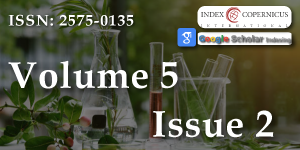Strobilurins: New group of fungicides
Main Article Content
Abstract
Strobilurin is a group of natural products and their synthetic analogs have been widely used to control and prevent fungal diseases. Strobilurins were firstly isolated in 1977 from the mycelium of Strobilurus tenacellus, a saprobic Basidiomycete fungus causing wood-rotting on forest trees. This group of pesticides was designed to manage fungal pathogens classes such as Ascomycetes, Basidiomycetes, and Oomycetes. Also, Strobilurin commercialized included derivatives such as are azoxystrobin, kresoxim-methyl, picoxystrobin, fluoxastrobin, oryzastrobin, dimoxystrobin, pyraclostrobin and trifloxystrobin. This group is a part of the larger group of QoI inhibitors, which act to inhibit the respiratory chain at the level of Complex III. Strobilurins group control an unusually wide array of fungal diseases, included water molds, downy mildews, powdery mildews, leaf spotting and rusts. This group are used on cereals, field crops, fruits, tree nuts, vegetables, turfgrasses and ornamentals. Also, Strobilurins found to enhance the plant growth in some cases.
Article Details
Copyright (c) 2021 Rasha E Selim, et al.

This work is licensed under a Creative Commons Attribution 4.0 International License.
The Journal of Plant Science and Phytopathology is committed in making it easier for people to share and build upon the work of others while maintaining consistency with the rules of copyright. In order to use the Open Access paradigm to the maximum extent in true terms as free of charge online access along with usage right, we grant usage rights through the use of specific Creative Commons license.
License: Copyright © 2017 - 2025 |  Open Access by Journal of Plant Science and Phytopathology is licensed under a Creative Commons Attribution 4.0 International License. Based on a work at Heighten Science Publications Inc.
Open Access by Journal of Plant Science and Phytopathology is licensed under a Creative Commons Attribution 4.0 International License. Based on a work at Heighten Science Publications Inc.
With this license, the authors are allowed that after publishing with the journal, they can share their research by posting a free draft copy of their article to any repository or website.
Compliance 'CC BY' license helps in:
| Permission to read and download | ✓ |
| Permission to display in a repository | ✓ |
| Permission to translate | ✓ |
| Commercial uses of manuscript | ✓ |
'CC' stands for Creative Commons license. 'BY' symbolizes that users have provided attribution to the creator that the published manuscripts can be used or shared. This license allows for redistribution, commercial and non-commercial, as long as it is passed along unchanged and in whole, with credit to the author.
Please take in notification that Creative Commons user licenses are non-revocable. We recommend authors to check if their funding body requires a specific license.
Feng Y, Huang Y, Zhan H, Bhatt Pand Chen S. An Overview of Strobilurin Fungicide Degradation:Current Status and Future Perspective. Front Microbiol. 2020; 11: 389. PubMed: https://pubmed.ncbi.nlm.nih.gov/32226423/
FRAC. QoI‐fungicides, FRAC code list 2011. www.frac.info
Philips McDougall. Agri Service. Products Section – 2016 Market.0 2017; 222–327.
Bartett DW, Clough JM, Godfrey CRA, Godwin JR, Hall AA, et al. Understanding the strobilurin fungicides. Pestic Outlook. 2001; 12: 143–148.
FAO Meeting. Azoxystrobin: Evaluation of Data for Acceptable Daily Intake and Acute Dietary Intake for Humans, Maximum Residue Levels and Supervised Trial Median Residue Values. 2008. http://www.fao.org/fileadmin/templates/agphome/documents/Pests_Pesticides/JMPR/Evaluation08/Azoxystrobin.pdf
Jeschke P, Witschel M, Krämer W. Ulrich Schirmer (eds.): Modern Crop Protection Compounds, 3rd edition, Wiley-VCH. 2019.
Siegfried W, Holliger E. Strobilurine im Weinbau—neue Versuchsergebnisse zur Bekampfung des Echten und Falschen Mehltaus. Schweiz Z Obst‐Weinbau. 1998; 4: 102– 104.
Broyard C, Margot P. La trifloxystrobine, une nouvelle substance active pour la protection fongicide de la vigne. Proc Sixieme Conf Internat Maladies des Plantes, ANPP, Tours. 2000; 935-942.
Anon. Fongicides cereales, leaflet produced by Institut Technique des Cereales et des Fourrages, France. 2001.
Bartlett DW, Clough JM, Godwin JR, Hall AA, Hamer M. The strobilurin fungicides. Pest Mana. Sci. 2002; 58: 637-744.
Vincelli P. QoI (Strobilurin) Fungicides: Benefits and Risks. The Plant Health Instructor. 2002.
Wu YX, von Tiedemann A. Physiological effects of azoxystrobin and epoxiconazole on senescence and oxidative status of wheat. Pestic Biochem Physiol. 2001; 71: 1–10.
Wu YX, von Tiedemann A. Impact of fungicides on active oxygen species and antioxidant enzymes in spring barley (Hordeum vulgare L.) exposed to ozone. Environ Pollut. 2002; 116: 37–47. PubMed: https://pubmed.ncbi.nlm.nih.gov/11808554/
Kohle H, Grossman K, Retzlaff G, Akers A, Limburgerhof G. Physiological effects of the new fungicide Juwel on yield in cereals. Gesunde Pflanzen. 1997; 49: 267–271.
Glaab J, Kaiser WM. Increased nitrate reductase activity in leaf tissue after application of the fungicide kresoxim-methyl. Planta. 1999; 207: 442–448.
Grossman K, Kwiatkowski J, Caspar G. Regulation of phytohormone levels, leaf senescence and transpiration by the strobilurin kresoxim-methyl in wheat (Triticum aestivum). J Plant Physiol. 1999; 154: 805–808.
Sauter H, Steglich W, Anke T. Strobilurins: Evolution of a New Class of Active Substances. Angew Chem Int Ed Engl. 1999; 38: 1328–1349. PubMed: https://pubmed.ncbi.nlm.nih.gov/29711574/
Hnátová M, Gbelská Y, Obernauerová M, Subíková V, Subík J. Cross-resistance to strobilurin fungicides in mitochondrial and nuclear mutantsof Saccharomyces cerevisiae. Folia Microbiol. 2003; 48: 496–500. PubMed: https://pubmed.ncbi.nlm.nih.gov/14533481/
Isamu Y, Makoto F. Recent topics on action mechanisms of fungicides. J Pestic Sci. 2005; 30: 67–74.
Balba H. Review of strobilurin fungicide chemicals. J Environ Sci Heal. 2007; B42: 441–451. PubMed: https://pubmed.ncbi.nlm.nih.gov/17474024/
Rodrigues ET, Lopes I, Pardal MA. Occurrence, fate and effects of azoxystrobin in aquatic ecosystems: a review. Environ Int. 2013; 53: 18–28. PubMed: https://pubmed.ncbi.nlm.nih.gov/23314040/
Pedersen M, Wegner C, Phansak P, Sarath G, Gaussoin RE, et al. Monitoring wheat mitochondrial compositional and respiratory changes using Fourier transform mid-infrared spectroscopy in response to agrochemical treatments. Spectrochimica Acta Part A Molecular and Biomolecular Spectroscopy. 2017; 173: 727-732. PubMed: https://pubmed.ncbi.nlm.nih.gov/27788471/

